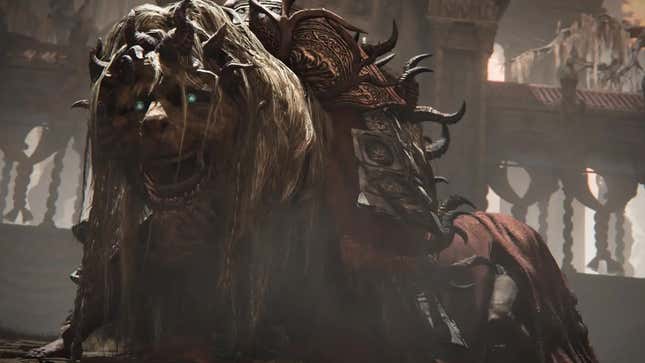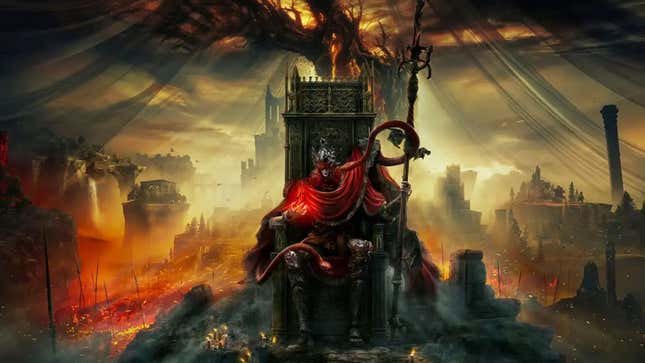The highly anticipated Elden Ring: Shadow of the Erdtree DLC releases in a month, and we just got a brand-new story trailer from developer FromSoftware to unpack while we wait.
The trailer delves into the story of Miquella, brother of the game’s hardest boss, Malenia, and son of Marika, former queen of the Lands Between and vessel of the Elden Ring itself. Though Elden Ring’s lore (which was created with some help from Game of Thrones author George R.R. Martin) is notoriously dense, there are plenty of connections to the medieval period—especially when it comes to the treatment of those born with deformities and afflictions. From what we see in the trailer, and what we know of Elden Ring’s world, I believe that we can draw some pretty clear lines between Miquella, the Omen, and Messmer, the DLC’s red-haired, snake-wrapped antagonist, and establish that Shadow of the Erdtree is about the redemption of this world’s outcasts.
But first, let’s try to unravel the tightly wound ball of yarn that is Elden Ring’s lore.
Explaining Elden Ring’s lore, briefly
At some point prior to the events of Elden Ring, the Greater Will showed up. The Greater Will is a sort of otherworldly parasite or ”Outer God” that is not from the Lands Between. Its will and influence manifests in the golden light, or grace, that you can see scattered across the land, in the Erdtree (the central tree in the Lands Between), and elsewhere. The Greater Will’s chosen vassal, Queen Marika, is given the Elden Ring, which is the physical manifestation of its power made up of several different runes. Marika also establishes the Golden Order, a theological belief system. The Ring also lends its power to the Erdtree.
Read More: 15 Elden Ring: Shadow Of The Erdtree Trailer Details You Might Have Missed
Pre-order Elden Ring: Shadow Of The Erdtree: Humble Bundle
Marika took Godfrey to be her king consort, and put him in charge of her armies. As Elden Lord, he helped established the Golden Order as the supreme law of the land, and they had three children together: Godwyn the Golden, and twins Morgott and Mohg, who were both born as Omen—accursed, horned creatures (we’ll get into that more later). Godfrey slayed all of Marika’s foes which solidified her reign, just to be banished from the Lands Between by her (likely because he’d served his purpose), thus becoming the first ever Tarnished.

Marika then took Radagon, another one of her most fearsome warriors, as her second husband—except Radagon is technically also Marika, yet another example of Elden Ring’s themes of twins/split personalities. It’s unclear how they become two halves of the same whole, but their duality is canonical. Marika and Radagon had two children (that we know of): twins Miquella and Malenia, who were both born accursed like Mogh and Morgott.
Miquella, determined to combat the afflictions he and his sister were born with (permanent childhood and Scarlet Rot, respectively), rejects the fundamentalism of the Golden Order and grows a golden tree by watering a seed with his own blood to create an Erdtree unbeholden to the Greater Will. This Haligtree became a symbol of hope for all of this world’s outcasts—those like the albinaurics and Omen who, prior to the establishment of the Golden Order, lived amongst the citizens of the Lands Between without issue.
Misfits, misbegotten, and Omen

Now, back to the Omen, who are reminiscent of the “monstrous births” from early and medieval Christianity. Back then, babies born with deformities were considered to be the result of a sinful mother—as Rebecca Kukla writes in Mass Hysteria: Medicine, Culture, and Mothers’ Bodies, authors of texts written between the 16th and early 18th centuries believed that “an expectant mother’s cravings, desires, and experiences…were capable of directly inscribing themselves upon the body of the fetus, producing deformities and monstrosities the retained the semantic content of the original impression.”
As author Jessica Thomas wrote in a post-graduate blog titled “Medieval Monsters: Deformed Birth in the Medieval Period,” the term “monster” comes from the Latin word “monstrum” which means, you guessed it: omen.
In Elden Ring, Omen are born ogre-like and covered in horns, and are considered monstrous things that must be cast out from the Lands Between. Omen children born to commonfolk must have their horns removed, which kills them, while the Omen born to nobility are squirreled away underground to live, but in shame.
As both GameRant and a very involved Reddit post detail, prior to the Golden Order and the flourishing of the Erdtree, the Primordial Crucible was the foundation of all life, and those born with its marks (horns, tails, what have you) were considered blessed. Omen were allowed to live normal lives amongst the other denizens of the Lands Between, but once the reign of the Primordial Crucible ended, the Omen’s existence is a reminder of the powers that ruled before the Greater Will, hence the desire to cast them out.
Marika banished her first-born twins, Morgott and Mohg, to the Subterranean Shunning-Grounds. But her second-born twins, Marika and Miquella, were not born Omen, just accursed, so they were allowed to remain on the surface. It’s unclear why Marika keeps producing these afflicted children—is it because the Greater Will wants to keep her in check, or is she guilty of unknown horrors? Her second set of twins were technically born only of her, as she is both Radogan and Marika—did she inscribe some of her “sin” onto them? It’s unclear, but she does have some pretty bad luck…
Miquella’s desire to cure himself and his sister of their afflictions put him on a path directly against the Greater Will. His creation of the Haligtree usurped the power of the Erdtree, and though the tree withers after his cocoon is stolen from it by Mohg (who hoped that he could use Miquella’s power to usher in a new dynasty that, one can presume, would not shun Omen), it still gains quite a loyal following of outcasts. I believe that Miquella was fighting against the discrimination imposed upon the people of the Lands Between by the Greater Will, which ultimately caused his demise and led him to flee (or be banished) to the Realm of Shadow.

How does Messmer the Impaler fit into this?
Messmer the Impaler is a brand-new antagonist introduced in the Elden Ring DLC. He lives in the Lands of Shadow, shares some similarities to Lord Rykard (snakes) and Malenia (red hair), and is considered to be “on equal footing to these other demigods and children of Marika,” according to an IGN interview with game director Hidetaka Miyazaki. I believe that Messmer might be Miquella and Malenia’s brother, conceived between her and Radogan outside of wedlock, as suggested by Redditor paperboatboi, banished to the Shadow Lands rather than to the Subterranean Shunning-Grounds so he cannot be traced.
In the official FromSoftware art for the Shadow of the Erdtree DLC, Messmer is sitting on Morgott’s throne. And in the trailer, we see several Omen skewered on massive spikes as the result of Messmer’s tyranny. Does he harbor anger towards the Omen because they were at least allowed to live in the Lands Between while he was not?
Or is he some sort of Golden Order religious extremist, determined to gain (or regain) footing in Marika’s world, driven mad by the prospect that anyone could be born who is considered Omen or Other? If so, that would explain his anger towards Miquella, whose creation of the Haligtree went against the Golden Order and also sought to help those who were disenfranchised.
Either way, I don’t think Messmer is a very nice guy, but I think we’ll learn a helluva lot more about how problematic the Golden Order is. And maybe, when Shadow of the Erdtree drops on June 21, we’ll help restore Miquella to the base of the Haligtree and usher in a new era in the Lands Between.

